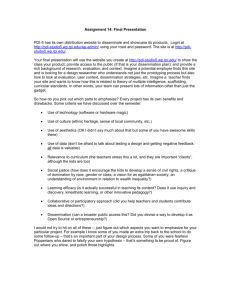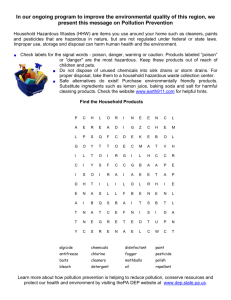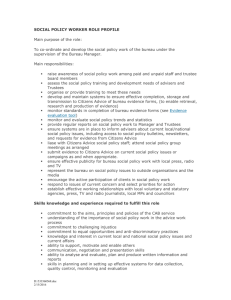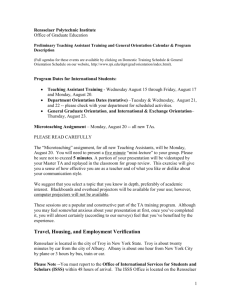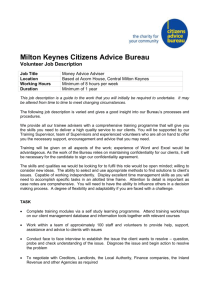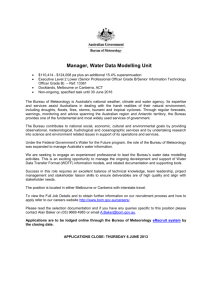Director
advertisement
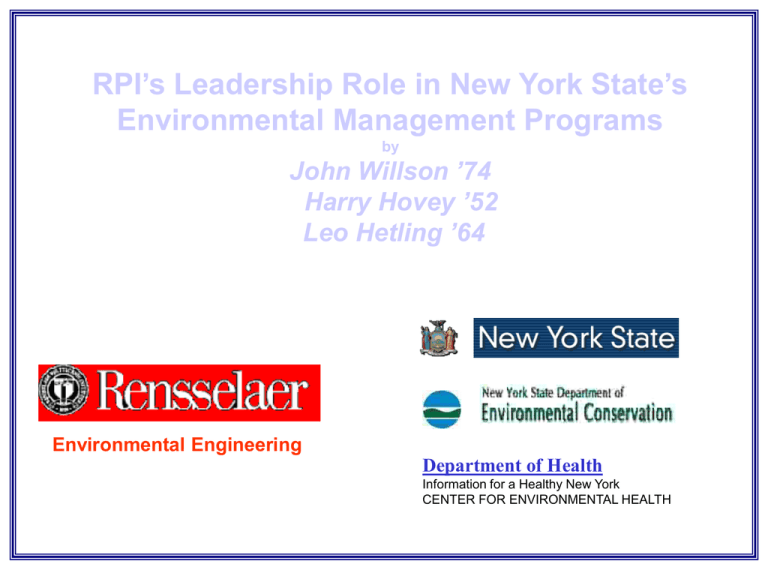
RPI’s Leadership Role in New York State’s Environmental Management Programs by John Willson ’74 Harry Hovey ’52 Leo Hetling ’64 Environmental Engineering Department of Health Information for a Healthy New York CENTER FOR ENVIRONMENTAL HEALTH RPI Environmental Pioneers William Pit Mason - Professor 1890- 1910- Environmental Chemist 1875 Walter Dauchy Review of Water Works at Hudson, NY 1876 William Henderson A Review of the Proposed West Troy Water Works 1877 Antonio Lavandeira Supply of Water for Troy, NY 1878 Kaname Haraguchi Review of the Pumping Engines and Boilers of the Albany City Water Supply 1887 Irving Matthews Design of a System of Water Works for the City of Troy, NY 1889 Paul O. Hebert Albany’s New Water Supply 1890 William Arnold Chemical Examination of the Troy Water Supply 1891 George Hallock Self Purification of the Hudson River between Troy and Albany 1893 Ralph Chambers Design for an additional Water Supply for the City of Troy, NY 1895 George A. Soper The Efficiency of the Public Water Supply Filter at Hudson, NY 1895 William C. Boyd Design for a New Water Supply for Albany, NY 1897 John A. Kingman An Investigation for an Improved Water Supply for the City of Albany, NY 1899 Lawrence L. Arnold An investigation Regarding the Suitability of the Hudson River and its Tributaries for Boiler Water 1913 Olin J. Magary Water Supply for a Part of Albany, NY 1925 Chang-Kan Chien Design for a Gravity Water Supply for Albany, NY 1937 Payl Royal Grossman Design and Economic Comparison for a Water Supply Some Early RPI - Health Department Environmental Leaders • • • • • • • John Bumstead, ’35 BCE, Irving Grossman, ’49 BCE, John C. Haberer ’31 BCE, Harry H. Hovey, ’52 BCE Sherwood Davis, ’40 BCE Meredith Thompson ’35 DCE Andrew Fleck, ’45 BX New York State Department of Health Milton T. Hill Meredith Thompson Alexander Rihm 1958 Professor Edward J. Kilcawley Environmental Engineering Questions 1. Was Professor Kilcawley’s vision of complex expanded environmental management needs realistic? 2. Did the need envisioned by Professor Kilcawley and the State managers for trained interdisciplinary professionals happen? 3. Did the RPI Environmental Engineering graduates make a difference? New York State Environmental Programs ~ 1958 Bureau of Sanitation Radiological Health and Air Pollution Control Section Sewage Section Water Supply Section Milk and Food Section Camp Sanitation Section Reality Subdivisions Department of Environmental Conservation 2005 Media Relations Press Office Office of Administration Division of Operations Division of Environmental Permits Division of Information Services Division of Management and Budget Division of Public Affairs and Education Office of Air and Waste Management Division of Air Resources Division of Solid & Hazardous Materials Division of Environmental Remediation Office of General Counsel Office of General Counsel Legal Affairs Environmental Justice Environmental Enforcement Office of Hearings and Mediation Services Office of Hearings and Mediation Services Office of Natural Resources and Water Quality Division of Fish Wildlife and Marine Resources Division of Lands and Forests Division of Mineral Resources Division of Water Office of Public Protection Division of Forest Protection and Fire Management Division of Law Enforcement Regional Offices Office of Labor Relations Legislative Relations Legislative Unit Special Programs within DEC Hudson River Estuary Program Great Lakes Program New York Natural Heritage Program Independent Boards that Work with DEC Freshwater Wetlands Appeals Board Conservation Fund Advisory Board Fish and Wildlife Management Board New York State Department of Health Center for Environmental Health Division of Environmental Health Assessment Bureau of Exposure Investigation Bureau of Toxic Substances Assessment Division of Environmental Protection Bureau of Radiological Health Bureau of Community Sanitation and Food Protection Bureau of Public Water Supply Division of Occupational Health & Bureau of Occupational Health Bureau of Occupational Health Bureau of Environmental Epidemiology 1990 RPI ALUMNI DIRECTORY 134 actively working Alumni at DEC 70 actively working Alumni at DOH RPI and Management of New York State's Water Program Fred Esmond Director Engineering and Program Development Division of Construction Grants, DEC William Muhall Sr. Engineer, DEC Bert Mead Charles DeFasio Regional Engineer, Director, Rensselaer County Sewer District Watertown Regional Office, DEC Anthony Adamczyk Albany Regional Director William Kivitt Fred Wurtemberger Director, Rensselaer County Sewer Bill Stasiuk Director, Environmental Health Center, DOH RPI and Management of New York State's Interstate and International Water Resources Delaware River Basin Commission Ohio River Valley Water Sanitation Commission Albert Bromberg ‘59 New England Interstate Water Pollution Control Commission Commissioner - Leo J. Hetling ‘64 Commissioner - Albert Bromberg ‘59 Commissioner - Sal Pagano ‘64 International Joint Commission Pollution From .Land Drainage Reference Group – Leo Hetling ‘64 Research Advisory Board – Leo Hetling ‘64 Great Lakes Water Quality Initiative Albert Bromberg ‘59 Water Quality Advisory Board – Sal Pagano ‘64 10000 9000 Millions of Dollars 8000 7000 6000 Total Federal State & Local 5000 4000 3000 2000 1000 0 1956 1966 1976 1986 Annual Capital Expenditures for Wastewater Treatment 1996 200,000 Total Load (Lbs/day) 180,000 160,000 140,000 Total SS 120,000 Total BOD 100,000 80,000 60,000 40,000 20,000 0 1900 1920 1940 1960 1980 Pollution Loads to the Lower Hudson River 2000 Dissolved Oxygen (mg/L) 10 9 8 7 6 5 4 3 2 1 0 1945 1955 1965 1975 1985 1995 Summer Average Dissolved Oxygen Hudson River Below Albany Total Number of Species 18 16 14 12 10 1973 1977 1983 1991 1997 2002 EPT trends (sensitive mayflies, stoneflies, and caddisflies) in the Hudson River at Troy, 1973-2002. (From Bode 2002) RPI and Management of New York State's Air Resources Program Beverly Rihm Technical Writer Paul Berry Director, Bureau Air Quality Surveillance Interstate and International Air Resources Acitvities State and Territorial Air Pollination Program Administrators, International Joint Commission, Northeastern States for Coordinated Air Use Management Harry Hovey Evolution of Air Resources Management Program >1957 Radiological Health and Air Sanitation Section Public Health Nuisances 1957 Air Pollution Control Section Air Pollution Control Act, Air Pollution Control Board Odors, Smoke, Air Monitoring 1964 Bureau of Air Regulatory Development, Standards 1966 Division of Air Resources Air Management, Modeling, Standards 1970 Division of Air Resources Transfer to Department of Environmental Conservation Automotive Emissions, Acid Rain, Ozone, Interstate Pollution Transport, Technology Standards RPI and Management of New York States Solid and Hazardous Waste Programs John Willson ’61 Director, Bureau Western Remedial Action John Hawley ‘70 Andy Carlson ’77 Director, Toxic Substance DOH Director, Environmental Exposure Investigation, DOH Solid Waste Management State Public Health Council in 1962 enacted a three page regulation which states that refuse disposal operations be conducted as sanitary landfills and municipal incinerators be operated so as to meet air pollution standards. Number of Landfills in New York State 1964 - 2002 1600 1600 1400 1200 1000 870 800 800 640 600 570 425 400 275 169 200 97 66 56 53 51 0 1964 1970 1974 1979 1982 1985 1988 1991 1993 1995 1996 1999 2002 Progress of Recycling in New York State 1989 - 1999 20 17.2 42% recycled 15 12.5 11.1 10 12.6 12 % incineration 10.7 8.5 7.2 32 % landfilled 5.7 5 4.3 4.8 3 14 % exported 0 1989 1990 12 % 17 % 1991 1992 19 % 2 3% 1993 28% 1994 1995 32% 39 % 1996 1997 3 8% 42% 1998 1999 42% 47 % % of the Solid Waste Stream Recovered Waste to energy Double lined landfill Management of Biosolids; Waste tires & Medical waste Hazardous Waste Management RCRA C Program Program Development • Regulate Hazardous Waste Transporters • Develop & Initiate Manifest System to Track Hazardous Waste from Cradle to Grave • Regulations Adopted 1982 • July 26, 1982 Interim Authorization • May 29, 1986 Final Authorization New York State TSDFs Universe Permit/Closure Summary Status of 68 Operating TSDFs Total RCRA-C Facilities - 308* 58 Fully Permitted, 10 Interim Status - IS 4 240 68 58 4 2 Closed/Inactive Ful ly Pe rmitte d C los ing -IS Operating To Be Perm itted -IS Pe rmi t D efer red -IS Insulation of Slurry Wall 315 facilities subject to corrective action 127 RFA DSHM 85 FSF- DER 2 USEPA 6 DSHM & DER 95 Completed RFA 18 NFA 77 FI 65 complete 12 RFI Hazardous Waste Inactive Sites Program Love Canal Trench 1927 Development of Program • 1979 Abandon Sites Act • 1980 Comprehensive Environmental Response, Compensation, and Liability Act (CERCLA) $ 1.6 Billion • 1982 & 1985 Superfund Law and Amendments • 1986 Bond Act $ 1.2 Billion Registry of Inactive Hazardous Waste Sites Source: NYSDEC Remedial Status Source: NYSDEC State Superfund Funding Sources Source: NYSDEC Tank Removal 443 sites in voluntary cleanup program private funds 75 sites in Environmental restoration Program municipal grants Other Programs Radiological Health Sherwood Davies ‘40 William Kelleher ‘66 Public Health Sanitation (Bathing Beaches, Children's Camps, Swimming) Pools) Howard Gates ‘61 Environmental problems international in scope. Energy Micro toxins, (Mercury, Pesticides, Pharmaceuticals) Facilities built in the 70s and 80s are reaching the end of their useful life New technology (Internet, DVDs and instant television conferencing) affecting the way engineers obtain information. In accordance with Professor Kilcawley’s vision, the program should be interdisciplinary with most courses taught outside the department and a close working relationship with government should be a priority. We would add to this a need to develop skills in management and communication. Vapor Intrusion into Homes Recycling and Waste Reduction are a necessity. Indoor Air Expectations and standards are rising. Top level management of environmental programs moving away from technical professionals. Maintain program commitment in difficult fiscal times. Resource Depletion
